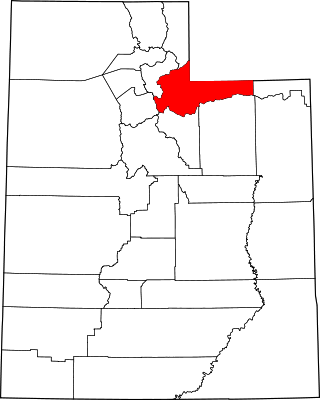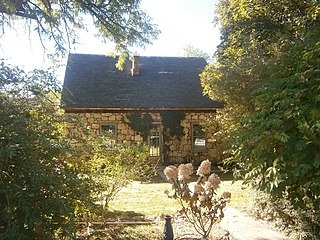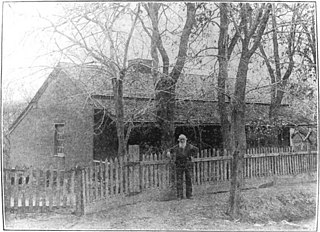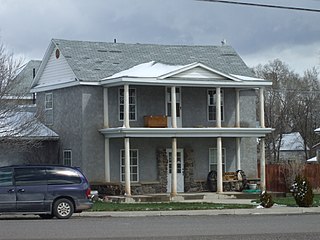
Camp Floyd State Park Museum is a state park in the Cedar Valley in Fairfield, Utah, United States. The park includes a small part of the former Camp Floyd site, the Stagecoach Inn, and the Fairfield District School.

Maeser Elementary was an elementary school in Provo, Utah. It was named after Karl G. Maeser. Built in 1898, it is the oldest school building in Provo, Utah. The school was designed by architect Richard C. Watkins, who also designed the Provo Third Ward Chapel and Amusement Hall, The Knight Block Building, and the Thomas N. Taylor Mansion.

Liberty Park is a popular public urban park in Salt Lake City, Utah. It is the city's second-largest public park, at 80 acres (32 ha), being surpassed only by Sugar House Park which has 110.5 acres (44.7 ha). The park features a pond with two islands, and is also the location of Tracy Aviary. The park is listed on the National Register of Historic Places (NRHP) and it includes the Isaac Chase Mill, which is also NRHP-listed.

This is a list of the National Register of Historic Places listings in Summit County, Utah.

The Henry J. Wheeler Farm is a farmstead in Murray, Utah, United States, that is one of the few remaining late 19th century farmsteads in the Salt Lake Valley that has not been lost to expanding housing developments of metropolitan Salt Lake City. It has been listed on the National Register of Historic Places since 1976.

The Harvey H. Cluff house is a house in central Provo, Utah, United States, built in 1877 that is on the National Register of Historic Places. It was originally owned by Harvey H. Cluff.

Mineral Hall in Kansas City, Missouri is a historic building constructed in 1903. An elaborate example of Prairie School architecture by Louis Singleton Curtiss, it originally served as a residence.

The George M. Brown House is a historic residence in Provo, Utah, United States, that is listed on the National Register of Historic Places. It was built as a home for a "polygamous wife" of lawyer George M. Brown. It is listed on the National Register of Historic Places.

The Pleasant Grove Historic District is a 112-acre (45 ha) historic district in Pleasant Grove, Utah, United States that was listed on the National Register of Historic Places in 1995.

The William Friend Young House at 550 E. Five Hundred N. in Pleasant Grove, Utah, United States, was built during 1885–86. Its exterior walls are soft rock. It was listed on the National Register of Historic Places in 1987.

The Sacred Heart Church in Tombstone, Arizona, United States, a Roman Catholic church, was established in 1881, as the first church of any denomination in rough-and-tumble Tombstone, founded in 1877, which had quickly become the largest and busiest city between San Francisco and St. Louis. It was only the sixth Catholic church in the Arizona Territory, and its 1882 building is the oldest known surviving frame church in Arizona. Its courtyard behind holds rose bushes of unusual size.

The Temple Town Hall, also known as the Union Hall and the Miller Grange Hall, is a historic municipal building in the center of Temple, New Hampshire. Built in 1842, it is a fine example of Greek Revival architecture, which has served the community as a church, Grange hall, and town hall. It continues to be used for social functions. The building was listed on the National Register of Historic Places in June 2007, and the New Hampshire State Register of Historic Places in April 2007.

The Cornwall Town Hall is located at 2629 Vermont Route 30 in Cornwall, Vermont. Built in 1880 and enlarged in 1905 to also house the local Grange chapter, it is one of the rural community's few examples of Italianate architecture, and has served as a community meeting point since its construction. It was listed on the National Register of Historic Places in 1986.

Eagar Townsite Historic District is a section of the town of Eagar, Arizona which has been designated a National Historic Place. Sitting on roughly 54 acres, the site contains 37 structures, 21 of which have historical significance. The period of significance is from 1886, the year the townsite was founded, through 1942, which represents the significant period of development of the town. The site was added to the Register on July 23, 1993.

The John Steele House is the historic home of a prominent early resident of Toquerville, Utah. One of the Mormon pioneers, John Steele built the house in 1862 and lived there until his death in 1903, working as an herbal physician and serving in a number of town and county offices. Its floor plan is a rare double-parlor style.

The Redmond Hotel, at 15 E. Main St. in Redmond, Utah, was built in 1879. It was listed on the National Register of Historic Places in 1980.
The Orlando W. Warner House, on S. Mill Creek Dr. in Moab, Utah, was built around 1890. It was listed on the National Register of Historic Places in 1977.

Las Saetas is one of the great examples of Pueblo Revival architecture in the American Southwest. Rebuilt in 1935 from the ruins of the 1873 Post Traders Store the design-build project was led by Dutch-born artist Charles Bolsius, with Nan and Pete Bolsius. The project included hand-carved doors, exposed beams, carved corbels, adobe fireplaces, hand-hammered tin, and a heightened sense of romanticism. The property and its transformation over a 150-year-span reflect the changing culture and economic milieu of Southern Arizona and the American West.



















